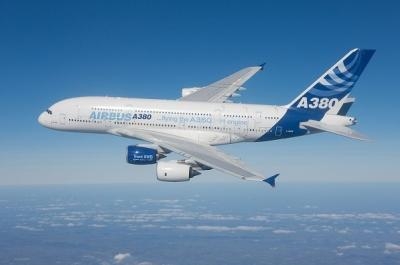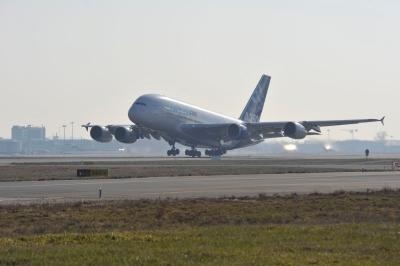Tue, Feb 21, 2012
Engine Flight-Test Campaign Underway One Year Ahead Of
Airplane’s First Flight
The A350 XWB’s new engine – the Rolls-Royce Trent
XWB – has successfully made its maiden flight aboard
Airbus’ dedicated A380 “Flying-Test-Bed”
aircraft. The aircraft took off from Airbus facilities in Toulouse
and performed a flight of more than five hours during which the
engine covered a wide range of power settings at altitudes up to
43,000ft. The aircraft handling qualities were evaluated from low
speeds to Mach 0.9. Rolls-Royce says the engine not only operated
flawlessly, but also demonstrated its new-generation fuel
efficiency and low noise.

The Trent XWB development engine, specially fitted with test
sensors to measure hundreds of parameters, was mounted on the
A380’s inner left engine pylon, replacing one of the
aircraft’s Trent 900 engines. The crew on board this first
flight were: Airbus Experimental test pilots Terry Lutz and Frank
Chapman; Experimental Test Flight Engineer Pascal Verneau; and
Flight Test Engineers Emanuele Costanzo and Tuan Do.
“The A350 XWB’s engine performed excellently during
its first flight-test, just as we expected,” said Charles
Champion, Executive Vice President of Engineering at Airbus.
“This is a promising start to the Trent XWB’s
flight-test program which will ensure a thorough real-life testing
of the engine, nacelle and its systems.” He adds: “This
will allow for a high level of powerplant integration, maturity and
reliability to be achieved by the time it flies on the first A350
XWB aircraft.”

Commencing around one year prior to the A350 XWB’s first
flight, this engine flight-test program is scheduled to accumulate
around 175 flight hours – some three times more airborne
flying hours than on previous programs. This will be accomplished
over a seven month period and will include hot weather as well as
icing condition testing campaigns. It will also test the advanced
nacelle and thrust reverser system provided by Goodrich.
The overall objective of these flight-tests is the early and
systematic validation of all performance aspects of the engine and
also the associated systems. In turn, this will contribute to
significantly ‘de-risking’ the A350 XWB’s
development well ahead of entry-into-service. The first results of
this flight-test campaign are expected this summer. (Photos
provided by Airbus)
More News
He Attempted To Restart The Engine Three Times. On The Third Restart Attempt, He Noticed That Flames Were Coming Out From The Right Wing Near The Fuel Cap Analysis: The pilot repor>[...]
Make Sure You NEVER Miss A New Story From Aero-News Network Do you ever feel like you never see posts from a certain person or page on Facebook or Instagram? Here’s how you c>[...]
From 2009 (YouTube Edition): Leading Air Show Performers Give Their Best Advice for Newcomers On December 6th through December 9th, the Paris Las Vegas Hotel hosted over 1,500 air >[...]
Aero Linx: NASA ASRS ASRS captures confidential reports, analyzes the resulting aviation safety data, and disseminates vital information to the aviation community. The ASRS is an i>[...]
“For our inaugural Pylon Racing Seminar in Roswell, we were thrilled to certify 60 pilots across our six closed-course pylon race classes. Not only did this year’s PRS >[...]
 NTSB Final Report: Rutan Long-EZ
NTSB Final Report: Rutan Long-EZ ANN FAQ: Turn On Post Notifications
ANN FAQ: Turn On Post Notifications Classic Aero-TV: ICAS Perspectives - Advice for New Air Show Performers
Classic Aero-TV: ICAS Perspectives - Advice for New Air Show Performers ANN's Daily Aero-Linx (06.28.25)
ANN's Daily Aero-Linx (06.28.25) Aero-News: Quote of the Day (06.28.25)
Aero-News: Quote of the Day (06.28.25)




